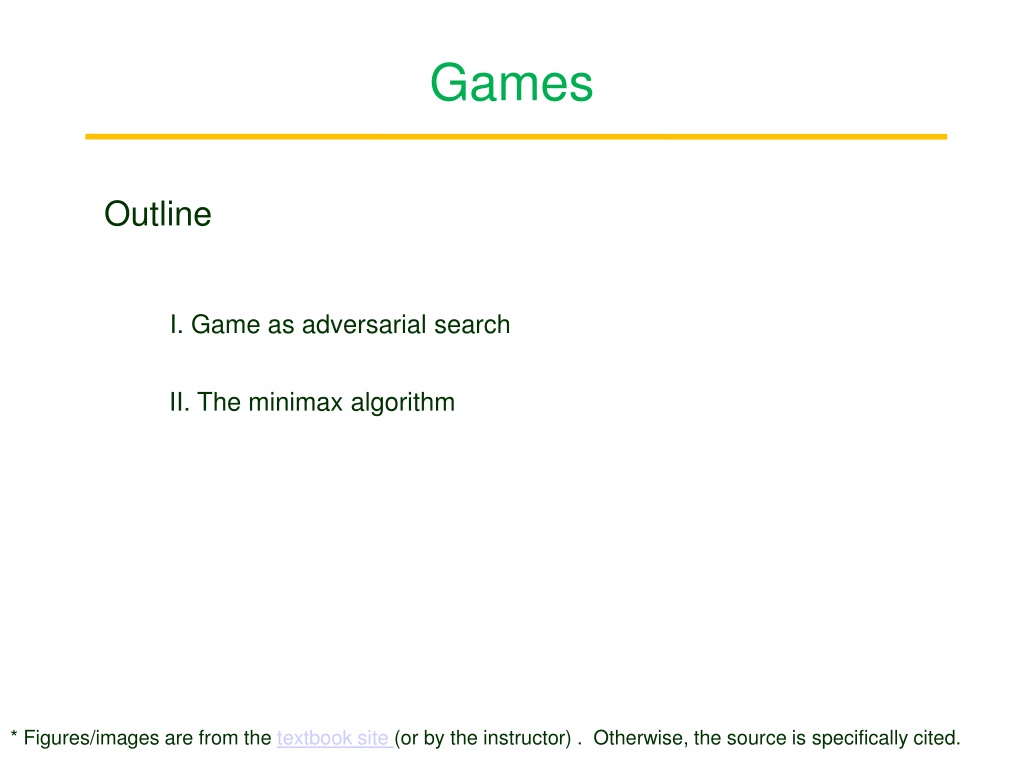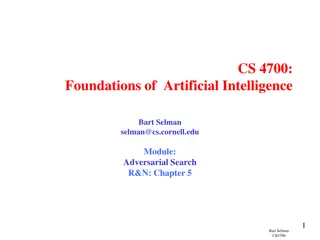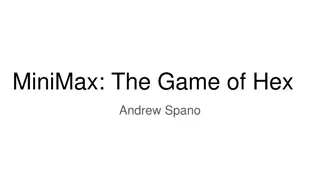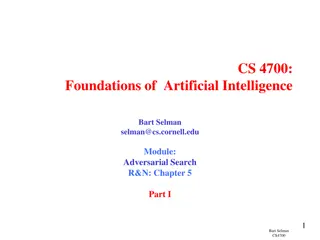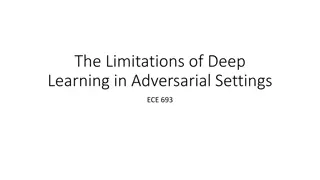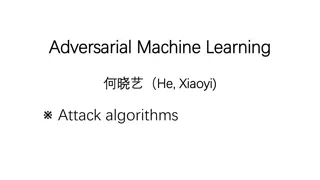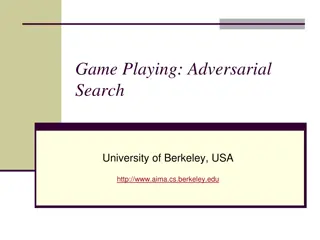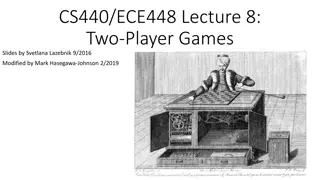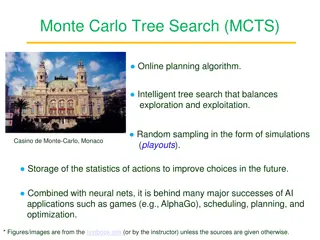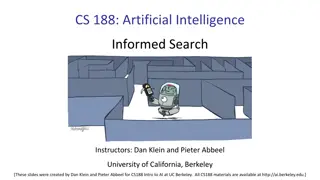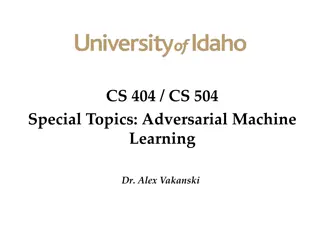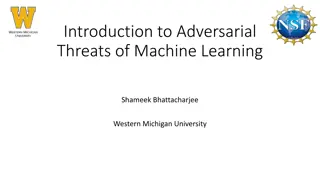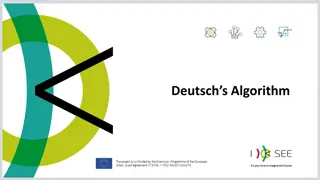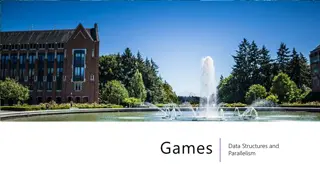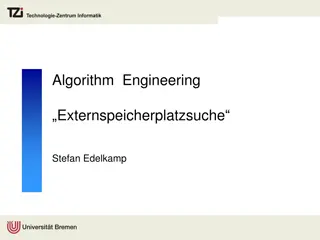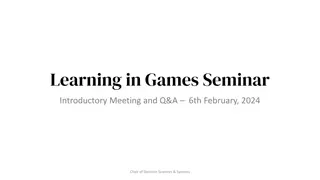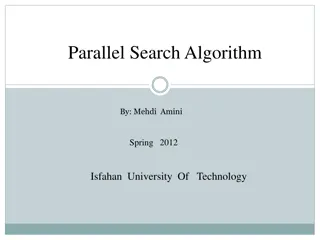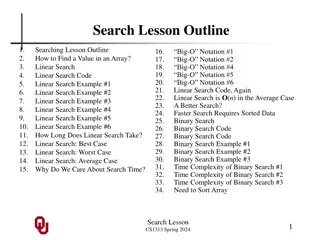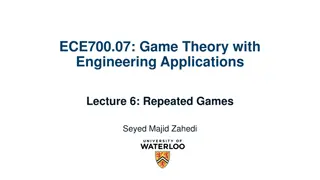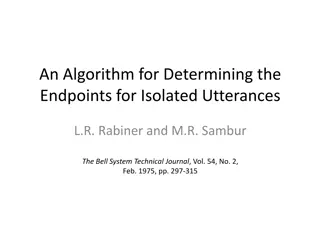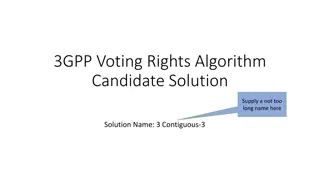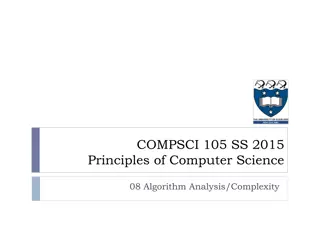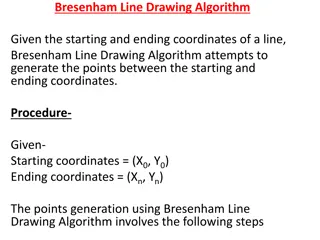Exploring Adversarial Search and Minimax Algorithm in Games
Competitive games create conflict between agents, leading to adversarial search problems. The Minimax algorithm, used to optimize player decisions, plays a key role in analyzing strategies. Studying games offers insights into multiagent environments, economic models, and intellectual engagement. The evolution of computer games, from chess programs by Shannon to AI victories in Go and poker, demonstrates the advancement of artificial intelligence in gaming. Understanding different game types and formal definitions enhances insight into two-player games and strategic decision-making.
Download Presentation

Please find below an Image/Link to download the presentation.
The content on the website is provided AS IS for your information and personal use only. It may not be sold, licensed, or shared on other websites without obtaining consent from the author. Download presentation by click this link. If you encounter any issues during the download, it is possible that the publisher has removed the file from their server.
E N D
Presentation Transcript
Games Outline I. Game as adversarial search II. The minimax algorithm * Figures/images are from the textbook site (or by the instructor) . Otherwise, the source is specifically cited.
I. Games Competitive environments: goals are in conflict. Adversarial search problems (games)
Why Study Games? Multiagent environment Aggregate of a large number of agents for predictions (e.g., price rise). Nondeterminism made by adversarial agents. Introduction of new modeling techniques. Mathematical game theory an important branch of economics. Nash equilibrium for a non-cooperative game: Each player has chosen a strategy and no player can increase own expected payoff by changing their strategy while the other players keep theirs unchanged,. John Nash (Princeton) Nobel Prize in Economics (1994) Appealing subject for study in AI. Fun and entertaining. Hard engaging the intellectual faculties of humans. Abstract nature easy to represent with small number of actions. * Photo from https://www.nobelprize.org/prizes/economic-sciences/1994/nash/facts/ .
History of Computer Games 1950 Claude Shannon, Programming a Computer for Playing Chess. 1956 John McCarthy conceives alpha-beta search. 1982 BELLE becomes the first chess program to achieve master status. 1984 Judea Pearl, Heuristics. 1997 Deep Blue (IBM) defeats world chess champion Garry Kasparov. Claude Shannon (MIT) 2017 AlphaGo (Alphabet) defeats world s no. 1 Go player Ke Jie. Father of information theory National Medal of Science (1966) Visual pattern recognition Reinforcement learning Neural networks Monte Carlo tree search 2018 AlphaZero (Alphabet) defeats top programs in Go, chess, shogi. 2019 Pluribus (CMU) defeats top-ranked players in Texas hold em games with six players. * Photo from https://en.wikipedia.org/wiki/Claude_Shannon.
Types of Games Games with deterministic, perfect information (e.g., chess, go, checkers) Stochastic games (e.g., backgammon) Probabilistic transitions by players Partially observable games (e.g., bridge, poker)
II. Two-Player Game Perfect information fully observable. Zero sum what is good for one player is just as bad for the other. move action position state MAX and MIN: two players.
Formal Definition of a Game ?0: initial state game setup. At a state ?: TO-MOVE(?): the player to move in the state. ACTIONS(?): the set of legal moves in the state. RESULT(?,?): the transition model defining the next state from taking action ?. IS-TERMINAL(?): to test if the game is over, i.e., if ? is a terminal state. UTILITY(?,?): a utility function to return a value to the player ? if the game ends in terminal state ?. e.g., in chess, win (1), loss (0), draw (1/2) Total payoff for all players is constant (zero-sum game): 1 + 0 = 0 + 1 =1 2= 1 2+1
State Space Graph (Tic-Tac-Toe) Vertices states and edges moves 9! = 362,880 terminal nodes (5,478 distinct states) 1040 for chess!
Two-Ply Game Tree Ply: one move by a player Utility values
Optimal Strategy Work out the minimax value of every state ? in the tree, MINIMAX(?) assuming both players play optimally: MAX moves to a state of maximum value at its turn; MIN moves to a state of minimum value at its turn. UTILITY(?, MAX) if IS-TERMINAL(?) ? ???????(?)MINIMAX(RESULT(?,?)) if TO-MOVE(?) = MAX ? ???????(?)MINIMAX(RESULT(?,?)) if TO-MOVE(?) = MIN max MINIMAX(?)= min
Minimax Value at Min Nodes MIN: choose a move to a MAX node with the lowest value. Minimax values
Minimax Value at a Max Node MAX: choose a move to a MIN node with the highest value.
Solution of the Game Best move for MAX: ?1 Best move for MIN in response: ?1
The Minimax Search Algorithm if player = MAXthenvalue, move MAX-VALUE( game, state ) elsevalue, move MIN-VALUE( game, state ) returnmove // ?2 is discarded // ?2 is discarded
Algorithm Execution Depth-first search with backed-up value on return from a node. 14 52
Summary on Minimax Complete if the game tree is finite. Optimal against an optimal opponent. If MIN does not play optimally, 1) MAX will play at least as well as an optimal player; 2) but there may be a better strategy against the suboptimal MIN. Complexities: branching factor max depth Space: ?(??) Time: ?(??) Chess: ? 35 and ? 100 for a reasonable game. Exact optimal solution infeasible!
Multiplayer Games Extend the minimax algorithm: Every node now has a vector of values. ??,??,?? for three players ?, ?, ? Utility vector Backed-up value at a node ?= utility vector of the successor state with the highest value for the player choosing at ?
